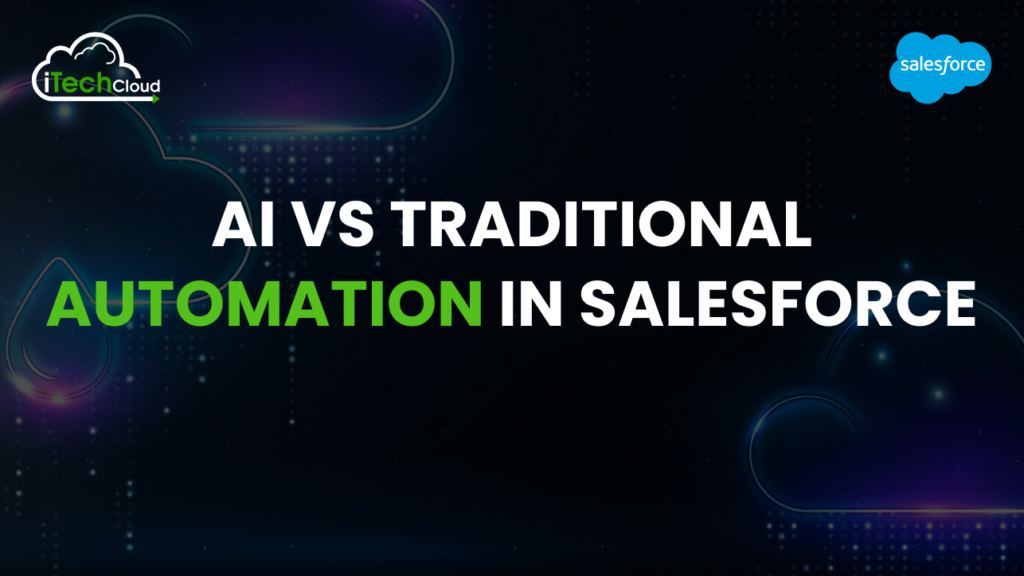AI Vs Traditional Automation in Salesforce

In the fast-evolving world of customer relationship management (CRM), Salesforce has emerged as a dominant player, helping businesses streamline operations, enhance customer engagement, and drive revenue. Two major approaches dominate the automation landscape in Salesforce: artificial intelligence (AI)-driven automation and traditional automation. Both have their advantages and limitations, and understanding their differences is crucial for businesses looking to maximize efficiency.
This blog post will provide a detailed comparison of AI vs. traditional automation in Salesforce, analyzing their applications, benefits, limitations, and future trends.
Table of Contents
Understanding Traditional Automation in Salesforce
What is traditional automation?
Traditional automation in Salesforce refers to rule-based workflows, macros, scripts, and process automation tools that execute predefined tasks based on logic set by administrators or developers. These automations do not have learning capabilities; they function based on if-then logic.
Key Features of Traditional Automation
Traditional automation is a structured approach to automating tasks based on predefined rules and logic. It follows a strict framework to ensure efficiency and consistency.
1. Rule-Based Execution
Traditional automation operates on manually set rules and conditions. It follows a structured logic defined by users, ensuring processes run as expected without deviation.
2. Predictable & Consistent
Since it strictly follows predefined rules, the output remains consistent. Given the same input, the system produces identical results, ensuring reliability in business processes.
3. No Learning Ability
Unlike AI-driven automation, traditional automation does not learn or improve over time. It cannot adapt to new scenarios or optimize itself beyond the initial configuration.
4. Trigger-Based Actions
Actions are initiated based on specific triggers such as user inputs, scheduled events, or data changes. This allows businesses to automate tasks like workflow approvals, email notifications, and data updates.
5. Integration with Salesforce Tools
Traditional automation integrates seamlessly with Salesforce tools like Process Builder, Flow, and Apex Triggers. These tools help automate repetitive tasks, enforce business rules, and streamline workflows within Salesforce.
Use Cases of Traditional Automation
Traditional automation in Salesforce provides efficiency by automating repetitive tasks and streamlining workflows. Some key use cases include:
1. Lead Assignment Rules
Automates lead distribution by assigning leads based on predefined criteria such as industry, territory, or business needs, ensuring quick follow-up.
2. Email Notifications
Triggers automated emails when specific conditions are met, such as sending confirmation emails to customers or notifying sales reps about new leads.
3. Data Validation Rules
Enforces data consistency by applying business rules to ensure valid inputs, such as requiring a phone number format or preventing duplicate records.
4. Scheduled Reports & Dashboards
Automates the generation and distribution of reports and dashboards at set intervals, helping stakeholders access real-time business insights.
5. Workflow Automation
Streamlines approvals and automates standard business processes, such as opportunity stage updates, task creation, or case escalations based on predefined triggers.
Limitations of Traditional Automation
Despite its benefits, traditional automation in Salesforce has certain limitations that restrict its efficiency in complex scenarios:
1. Lack of Adaptability
Traditional automation relies on static rules and lacks the ability to learn from historical data or user behavior, making it inefficient in dynamic environments.
2. Complex Rule Management
As business processes evolve, maintaining and updating rule-based automation becomes cumbersome, requiring frequent manual intervention.
3. Limited Scalability
Handling large datasets can lead to performance bottlenecks, as traditional automation rules may not scale efficiently with increased data complexity.
4. Inability to Handle Unstructured Data
Traditional automation struggles to process unstructured data such as images, voice inputs, or free-text responses, limiting its usability in modern AI-driven workflows.
Understanding AI-Driven Automation in Salesforce
What is AI-Driven Automation?
AI-driven automation in Salesforce leverages machine learning (ML), natural language processing (NLP), and predictive analytics to automate tasks, generate insights, and improve decision-making. Salesforce’s AI-powered solution, Einstein AI, enhances CRM functionalities by learning from historical data and continuously optimizing processes.
Key Features of AI-Driven Automation
1. Self-Learning Capabilities
AI models continuously learn from data, improving accuracy in predictions and automations over time.
2. Predictive Analytics
AI helps forecast sales trends, lead conversions, and customer behavior, allowing businesses to make data-driven decisions.
3. Natural Language Processing (NLP)
AI enhances customer interactions by analyzing text and voice data, improving support and sentiment analysis.
4. Personalization
AI tailors recommendations based on user behavior, increasing engagement and customer satisfaction.
5. Conversational AI
AI-driven chatbots and virtual assistants enhance customer support by providing real-time assistance.
Use Cases of AI-Driven Automation in Salesforce
1. Lead Scoring & Prioritization
AI ranks and scores leads based on their conversion probability, helping sales teams focus on high-potential leads.
2. Predictive Forecasting
AI predicts future sales based on historical data, allowing businesses to make informed financial and operational decisions.
3. Sentiment Analysis
AI processes customer feedback to assess satisfaction levels and identify potential issues.
4. Chatbots & Virtual Assistants
AI-powered chatbots handle routine inquiries, improving response times and customer experience.
5. Automated Data Entry
AI extracts, cleans, and inputs data into Salesforce, reducing manual errors and improving efficiency.
6. Customer Behavior Analysis
AI segments customers based on their interactions, enabling businesses to deliver targeted marketing campaigns.
Advantages of AI-Driven Automation
1. Adaptive Learning
AI continuously improves its performance, reducing the need for manual adjustments.
2. Improved Decision-Making
AI provides valuable insights, enabling businesses to make strategic, data-driven decisions.
3. Scalability
AI can process and analyze vast amounts of data efficiently, making it ideal for large enterprises.
4. Customer Experience
AI-driven personalization improves engagement, retention, and customer satisfaction.
5. Time & Cost Savings
Automating repetitive tasks frees up human resources for more strategic work, reducing operational costs.
Limitations of AI-Driven Automation
1. Complex Implementation
Deploying AI solutions requires expertise in model training and integration with existing systems.
2. Higher Initial Investment
AI-driven automation demands significant upfront costs compared to traditional automation.
3. Data Dependency
AI relies on high-quality data; poor or biased data can lead to inaccurate predictions and decisions.
4. Ethical & Compliance Concerns
AI models must ensure transparency, fairness, and compliance with regulations to avoid biases and ethical dilemmas.
The Future Trends in AI vs Traditional Automation in Salesforce
Salesforce is evolving rapidly with AI and automation, transforming customer relationship management (CRM). The future trends in AI and traditional automation within Salesforce focus on efficiency, personalization, and predictive analytics.
AI in Salesforce
1. Einstein AI Enhancements
Salesforce’s AI tool, Einstein, is improving with better natural language processing (NLP) and machine learning (ML). It will automate data insights, predictive lead scoring, and personalized recommendations.
2. Generative AI for CRM
AI-driven chatbots, automated email responses, and intelligent data analysis will make CRM more proactive and insightful.
3. AI-Powered Sales and Marketing
AI will refine sales forecasting, customer segmentation, and campaign optimization, leading to higher conversion rates.
4. Hyper-Personalization
AI will enable deeper customer insights, allowing businesses to tailor interactions and recommendations in real time.
Traditional Automation in Salesforce
1. Robotic Process Automation (RPA)
Salesforce will integrate more with RPA tools to automate repetitive tasks, such as data entry and validation.
2. Workflow Automation
Enhanced Process Builder and Flow capabilities will reduce manual interventions, boosting operational efficiency.
3. Low-Code/No-Code Automation
Salesforce is simplifying automation development, making it easier for businesses to build workflows without coding expertise.
4. Integration with IoT and Edge Computing
Automated workflows will integrate with IoT devices for real-time data processing and automation.
Conclusion
AI-driven automation and traditional automation in Salesforce serve different purposes but complement each other. While traditional automation handles repetitive tasks efficiently, AI-driven automation enhances decision-making, personalization, and predictive capabilities. Businesses looking to stay competitive should embrace AI alongside traditional automation to maximize efficiency and customer engagement.

